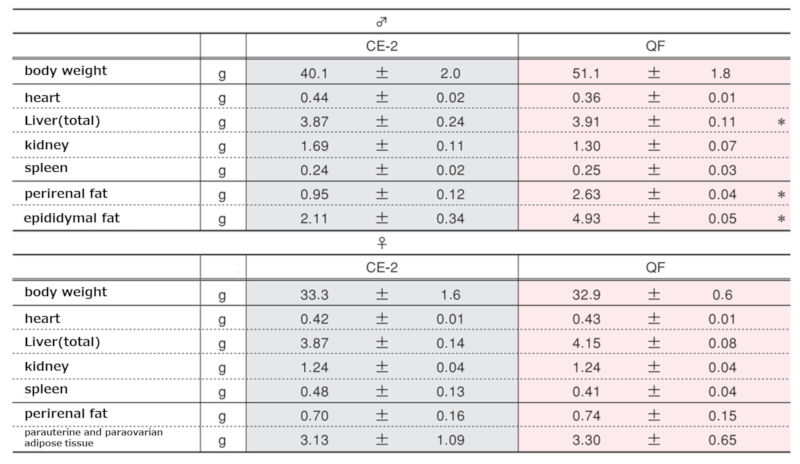
Diet Research Data:Effects of Quick Fat Diet on Male and Female ICR Mice
Related CLEA Japan product: Quick Fat

For the animal, please click here↓![]() : https://www.clea-japan.com/en/products/general_diet/item_d0070
: https://www.clea-japan.com/en/products/general_diet/item_d0070
Inquiry:
If you have any question, please feel free to contact us from here.
1.Objective
This study examined the effects of a high-fat diet (Quick Fat) on obesity and insulin resistance in ICR mice.
2.Materials and Methods
(1)Experimental Site
The experiment was conducted in the mouse breeding room (conventional) of the Central Research Institute of Nippon Compound Feed Co., Ltd. (currently Feed One Co., Ltd.).
(2)Diet
- CE-2: Crude fat content 4.6%, Fat kcal% 11.9%, Soluble non-nitrogenous substance content 51.4%, NFE kcal% 59.3%
- Quick Fat (QF): Crude fat content 13.6%, Fat kcal% 29.8%, Soluble non-nitrogenous substance content 47.8%, NFE kcal% 46.6%
(3)Animals
Male and female Jcl:ICR mice were introduced at 3 weeks of age and acclimatized for 1 week. After that, they were divided into two groups (control group: fed CE-2, experimental group: fed QF) based on body weight, and fed their respective diets ad libitum from 4 to 25 weeks of age. The number of mice in each group was 8 for both males and females.
(4)Housing
- Temperature and humidity: Temperature = 24-27°C, Humidity = 50-70%
- Lighting: 12-hour light-dark cycle (lights on 9:00-21:00)
- Cages: Individually housed in polycarbonate cages with sterilized chips
- Diet: Ad libitum
- Drinking water: Ad libitum
(5)Experimental Procedures
During the feeding period, body weight, food intake, and water intake were measured weekly. Blood samples were collected from the tail vein after a 20-hour fast at 4, 6, 8, 10, 14, 18, and 22 weeks of age. At the end of the feeding period (25 weeks of age), an oral glucose tolerance test (glucose dose = 2 g/kg body weight) was performed, followed by Biopsy of 6 mice per group. After a 20-hour fast under ether anesthesia, blood was collected from the posterior vena cava, and major organs and peritoneal adipose tissue were removed. Blood was stored as serum for the measurement of lipid metabolism-related parameters (triglycerides, free fatty acids, total cholesterol, esterified cholesterol, free cholesterol, and phospholipids). Student's t-test was used for statistical analysis.
3.Results
The results are described below.
1.Body Weight
Differences in Body Weight Changes Between Sexes
Body weight was measured weekly. The points and vertical lines in the figure represent the mean ± standard error. Statistical analysis was performed between groups within the same sex at each age, and * indicates a significant difference (p < 0.05).


2.Food and Water Intake
Differences in Food Intake Between Sexes
The points and vertical lines in the figure represent the mean ± standard error.


Differences in Water Intake Between Sexes
The points and vertical lines in the figure represent the mean ± standard error.


3.Fasting Blood Glucose Levels
Differences in Fasting Blood Glucose Levels Between Sexes
Blood samples were collected from the tail vein every 2 weeks at 1 pm, 4 hours after lights on. Whole blood was measured using a whole blood glucose meter (Glucotest PROR / Sanwa Kagaku Kenkyusho Co., Ltd.). The vertical bars and lines in the figure represent the mean ± standard error. Statistical analysis was performed between groups within the same sex at each age, and * indicates a significant difference (p < 0.05).


4.Oral Glucose Tolerance Test
Results of Oral Glucose Tolerance Test in ICR Mice at 25 Weeks of Age - 1
After an overnight fast (20 hours), a glucose solution (2g/kg body weight) was orally administered via gastric gavage, and blood was collected from the tail vein before administration (0 min) and 30, 60, and 120 min after administration. The obtained blood was stored as plasma at -40°C. Blood glucose levels were measured using the Glucose CⅡ - Test Wako (Wako Pure Chemical Industries, Ltd.). The points and vertical lines in the figure represent the mean ± standard error. Statistical analysis was performed between groups at each time point, and * indicates a significant difference (p < 0.05).


Results of Oral Glucose Tolerance Test in ICR Mice at 25 Weeks of Age – 2
【Sum of Blood Glucose Levels and Blood Glucose Increment Area】
The sum of blood glucose levels was calculated for each time point during the oral glucose tolerance test. The blood glucose increment area was calculated using the following formula:
Blood glucose increment area (mg/dl・h) = {(a + 2b + 3c + 2d) × 1/4} - 2a
(where a, b, c, and d are the blood glucose levels at 0, 30, 60, and 120 minutes, respectively)
The vertical bars and lines in the figure represent the mean ± standard error. Statistical analysis was performed between groups, and * indicates a significant difference (p < 0.05).


5.Insulin Tolerance Test
Results of Insulin Tolerance Test in ICR Mice at 25 Weeks of Age
An insulin solution (0.75 IU/kg body weight) was intraperitoneally injected, and blood was collected from the tail vein before administration (0 min) and 20, 40, 60, 80, and 120 min after administration. Whole blood glucose levels were measured using a whole blood glucose meter (Glucotest PROR / Sanwa Kagaku Kenkyusho Co., Ltd.). The points and vertical lines in the figure represent the mean ± standard error. Statistical analysis was performed between groups at each time point, and * indicates a significant difference (p < 0.05).


6.Blood Analysis at Biopsy
Serum and Plasma Analysis at Biopsy
The values in the table represent the mean ± standard error. At 25 weeks of age, blood was collected after a 20-hour fast under ether anesthesia. Blood was collected from the posterior vena cava and stored as plasma and serum. Statistical analysis was performed between groups for each item, and * indicates a significant difference (p < 0.05).

7.Major Organ Weights at Biopsy
Organ Weights
The values in the table represent the mean ± standard error. Statistical analysis was performed between groups for each item, and * indicates a significant difference (p < 0.05).



